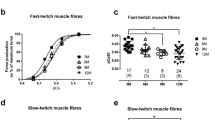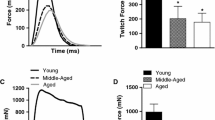Abstract
Samples of semitendinosus muscle from 28 male cattle (18 Salers and 10 Limousins) were taken at 10 months (biopsy) and at 16 months of age (at slaughter). The animals had received the same diet and were slaughtered after the same duration of fattening. The activities of isocitrate dehydrogenase and lactate dehydrogenase were measured in the muscle samples. The five lactate dehydrogenase isoenzymes were separated by electrophoresis under non-denaturing conditions and assayed by densitometry. Fibres were identified by histochemistry by myofibrillar ATPase and succinate dehydrogenase activities as SO (slow oxidative), FOG (fast oxidative glycolytic) or FG (fast glycolytic), and by immunohistochemistry by their reaction to monoclonal antibodies specific to slow and fast myosin heavy chain reactions in I, IIC, IIA, IIAB and IIB type fibres. The isocitrate dehydrogenase activity was not modified between 10 and 16 months of age; the lactate dehydrogenase activity decreased and was correlated with an increase in the proportion of the H isozyme to the detriment of the proportion of the M form. This period was characterized by an increase in fibre size, increased expression of MHC IIa, resulting in more IIA fibres, less IIB fibres, and an increase in the percentage of type IIAB fibres, however the proportions of SO, FOG and FG, when analysed statistically, were not modified between 10 and 16 months of age.
Similar content being viewed by others
References cited
Ansay M (1974) Individualité musculaire chez le bovin: étude de l'équipement enzymatique de quelques muscles. Ann Biol An Bioch Bioph 14: 471–486.
Apple FS, Tesch PA (1989) CK and LD isoenzymes in human single muscle fibers in trained athletes. J Appl Physiol 66(6): 2717–2720.
Briand M, Talmant A, Briand Y, Monin G, Durand R (1981a) Metabolic types of muscle in the sheep: I. Myosin ATPase, glycolytic and mitochondrial enzyme activities. Eur J Appl Physiol 46: 347–358.
Briand M, Talmant A, Briand Y, Monin G, Durand R (1981b) Metabolic types of muscle in the sheep: II. Lactate dehydrogenase activity and LDH isozyme distribution. Eur J Appl Physiol 46: 359–365.
Briand M, Briand Y (1986) Metabolic and contractile properties of rabbit muscles: a statistical approach. Comp Biochem Physiol 85: 481–485.
Brandstetter AM, Picard B, Geay Y (1998a) Muscle fibre characteristics in four muscles of growing bulls. I. Postnatal differentiation. Livestock Prod Sc 53: 15–23.
Brandstetter AM, Picard B, Geay Y (1998b) Muscle fibre characteristics in four muscles of growing bulls. II. Effect of castration and feeding level. Livestock Prod Sc 53: 25–36.
Brooke MH, Kaiser KK (1970) Muscle fibre types: how many and what kind? Arch Neurol 23: 369–379.
Damergi C (1996) Evolution des caracteristiques du collagène du muscle squelettique chez le bovin mâle entre 4 et 16 mois: incidences de la castration précoce et de la modulation du rythme de croissance. Thèse. Dr. Clermont-Ferrand, 91p.
Dreyer, JH, Gilmour RS, Henning JWN, Rossouw E (1977) The influence of breed, castration and age on muscle fibre type and diameter in Friesland and Afrikaner cattle. S Afr J Anim Sci 7: 171–180.
Fritz PF, Morrison WJ, White EL, Vesell ES (1970) Comparative study of methods of quantifying lactate dehydroganase isoenzymes. Analytical Biochemistry 36: 443–453.
Gagniere H, Picard B, Jurie C, Geay Y (1997) Comparative study of metabolic differentiation of foetal muscle in normal and double-muscled cattle. Meat Sc 45(2): 145–152.
Guth L, Samaha FJ (1970) Procedure for the histochemical demonstration of actomyosin ATPase. Exp Neurol 28: 365–367.
Hämäläinen N, Pette D(1995) Patterns of myosin isoforms in mammalian skeletal muscle fibres. Micros Res and Tech 30: 381–389.
Jurie C, Robelin J, Picard B, Renand G, GeayY(1995) Postnatal changes in the biological characteristics of Semitendinosus muscle in male Limousin cattle. Meat Sc 41: 125–135.
Klosowski B, Bidwell-Porebska K, Klosowska D, Piotrowski J (1992) Microstructure of skeletal muscles of growing calves fed silage-based vs hay-based diets. II. Fibre type distribution. Reprod Nutr Dev 32: 257–263.
Larsson L, Li X, Teresi A, Salviati G (1994) Effects of thyroid hormone on fast-and slow-twitch skeletal muscles in young and old rats. J Physiol Lond 481: 149–161.
Leberer E, Pette D (1984) Lactate dehydrogenase isoenzymes in type I, IIA and IIB fibres of rabbit skeletal muscles. Histochemistry 80: 295–298.
Lyons G, Kelly A, Rubinstein W (1986) Testosterone-induced changes in contractile protein isoform in sexually dimorphic temporalis muscle of the guinea pig. J Biol Chem 26: 13276–13284.
Martinez-Galisteo A, Diz A, Aguera E, Vivo J (1992) Influence of age on fibre type characteristics in the middle gluteal muscle of Andalusian foals. Histol Histopath 7: 157–162.
Morano I, Gerstner J, Ruegg JC, Ganten U, Ganten D, Vosberg P (1990) Regulation of myosin heavy chain expression in the hearth of hypertensive rats by testosterone. Circ Res 66: 1585–1590.
Ockerman HW, Jaworek, Vanstavern B, Parrett, Pierson CJ (1984) Castration and sire effects on carcass traits, meat palatability and muscle fibre characteristics in Angus cattle. J Anim Sci 59(4): 981–990.
Pearse AGE (1968) Histochemistry: Theoritical and Applied. Vol 2 3rd Edn, London: Churchill JA, pp. 1342.
Peter JB, Barnard RJ, Edgerton VR, Gillepsie CA, Stempel KE (1972) Metabolic profiles of three fiber types of skeletal muscle in guinea pigs and rabbits. Biochemistry 11(14): 2627–2633.
Pette D (1984) Activity-induced fast to slow transitions in mammalian muscle. Med Sci Sp Ex 16: 517–528.
Pette D, Staron RS (1990) Cellular and molecular diversities of mammalian skeletal muscle fibres. Rev Physiol Biochem Pharmacol 116: 1–75.
Picard B, Gagniere H, Geay Y, Hocquette JF, Robelin J (1995a) Study of the influence of age and weaning on the contractile and metabolic characteristics of bovine muscle. Reprod Nutr Dev 35: 71–84.
Picard B, Robelin J, Geay Y(1995b) Influence of castration and postnatal energy restriction on the contractile and metabolic characteristics of bovine muscle. Ann Zootech 44: 347–357.
Picard B, Duris MP, Jurie C (1998a) Caractérisation des chaînes lourdes de myosine dans le muscle de bovin. INRA Prod Anim 11(2): 150–152.
Picard B, Duris MP, Jurie C (1998b). Classification of bovine muscle fibres by different histochemical techniques. Histochem J 30: 473–479.
Roneus M (1993) Muscle characteristics in Standardbreds of different ages and sexes. Eq Vet J 25(2): 143–146.
Sas (1985) STAT Guide for Personal Computers Version 6, edn, SAS Institute, Cary, NC.
Schiaffino S, Gorza L, Sartore S, Saggin L, Ausoni S, Vianello M, Gundersen K, Lomo T (1989) Three myosin heavy chain isoforms in type 2 skeletal fibres. J Muscle Cell Motil 10: 197–205.
Seedorf L, Leberer E, Kirschbaum BJ, Pette D (1986) Neural control of gene expression in skeletal muscle. Effects of chronic stimulation on lactate dehydrogenase isoenzymes and citrate synthase. Biochem J 239: 115–120.
Seideman SC, Crouse JD, Cross HR (1986) The effect of sex condition and growth implants on bovine muscle fibre characteristics. Meat Sci 17: 79–95.
Seideman SC, Crouse JD (1986) The effect of sex condition, genotype and diet on bovine muscle fibre characteristics. Meat Sci 17: 55–72.
Solomon MB, West RL, Hentges JF (1986) Growth and muscle development characteristics of purebred Angus and Brahman bulls. Growth 50: 51–67.
Spindler AA, Mathias MM, Cramer DA(1980) Growth changes in bovine muscle fiber types as influences by breed and sex. J Food Sci 45: 29–31.
Sugiura T, Matoba H, Miyata H, Kawai Y, Murakami N (1992) Myosin heavy chain isoform transition in ageing fast and slow muscles of the rat. Acta Physiol Scand 144: 419–423.
Sullivan VK, Powers SK, Criswell DS, Tumer N, Larochelle JS, Lowenthal D (1995) Myosin heavy chain composition in young and old rat skeletal muscle: effects of endurance exercise. J Appl Physiol 78(6): 2115–2120.
Thorling EB, Jensen K (1966) The lactate dehydrogenase isoenzymes in various organs of the rabbit in anemia, hypoxia and after cobalt administration. Acta Pathologica et Microbiologica Scandinavia 66: 426–436.
Vigneron P, Dainat J, Bacou F (1989) Propriétés des fibres musculaires squelettiques. II. Influences hormonales. Reprod Nutr Develop 29: 27–53.
Young OA, Bass JJ (1984) Effect of castration on bovine muscle composition. Meat Sci 11: 139–156.
Author information
Authors and Affiliations
Rights and permissions
About this article
Cite this article
Jurie, C., Picard, B. & Geay, Y. Changes in the Metabolic and Contractile Characteristics of Muscle in Male Cattle Between 10 and 16 Months of Age. Histochem J 31, 117–122 (1999). https://doi.org/10.1023/A:1003589320910
Issue Date:
DOI: https://doi.org/10.1023/A:1003589320910




